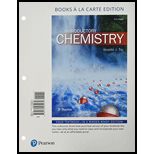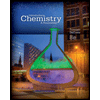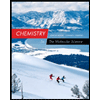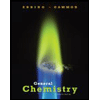
Introductory Chemistry, Books a la Carte Plus Mastering Chemistry with Pearson eText -- Access Card Package (6th Edition)
6th Edition
ISBN: 9780134557311
Author: Nivaldo J. Tro
Publisher: PEARSON
expand_more
expand_more
format_list_bulleted
Concept explainers
Textbook Question
Chapter 5, Problem 8E
What is a structural formula? What is the difference between a structural formula and a molecular model?
Expert Solution & Answer
Want to see the full answer?
Check out a sample textbook solution
Students have asked these similar questions
pls help asap on all.
pls help asap on all.
pls help asap on all.
Chapter 5 Solutions
Introductory Chemistry, Books a la Carte Plus Mastering Chemistry with Pearson eText -- Access Card Package (6th Edition)
Ch. 5 - Q1. Carbon tetrachloride has a chlorine - to-...Ch. 5 - Write a chemical formula for a compound that...Ch. 5 - Q3. How many oxygen atoms are in the chemical...Ch. 5 - Which element is a molecular element? a. Copper b....Ch. 5 - Q5. Which compound is ionic?
a.
b.
c.
d.
Ch. 5 - Write a formula for the compound that forms...Ch. 5 - Prob. 7SAQCh. 5 - Prob. 8SAQCh. 5 - Name the compound CrCl3 a. monochromium...Ch. 5 - Name the compound BaSO4 a. barium sulfate b....
Ch. 5 - Name the compound PF5. a. monophosphorus...Ch. 5 - Q12. What is the formula for manganese (III)...Ch. 5 - Q13. Name the acid (aq).
a. hydrogen phosphate
b....Ch. 5 - What is the formula for hydrobromic acid? a. HBr...Ch. 5 - Prob. 15SAQCh. 5 - 1. Do the properties of an element change when it...Ch. 5 - How might the world be different if elements did...Ch. 5 - What is the law of constant composition? Who...Ch. 5 - 4. What is a chemical formula? List some examples....Ch. 5 - 5. In a chemical formula, which element is listed...Ch. 5 - Prob. 6ECh. 5 - 7. Explain the difference between a molecular...Ch. 5 - What is a structural formula? What is the...Ch. 5 - What is the difference between a molecular element...Ch. 5 - Prob. 10ECh. 5 - What is the difference between a common name for a...Ch. 5 - List the metals that only one type of ion (that...Ch. 5 - Prob. 13ECh. 5 - Prob. 14ECh. 5 - Prob. 15ECh. 5 - Prob. 16ECh. 5 - Prob. 17ECh. 5 - Prob. 18ECh. 5 - What is the basic form for the named of molecular...Ch. 5 - How many atoms does each prefix specify? Mono-,...Ch. 5 - Prob. 21ECh. 5 - Prob. 22ECh. 5 - Prob. 23ECh. 5 - Prob. 24ECh. 5 - Two samples of sodium chloride are decomposed into...Ch. 5 - Two samples of carbon tetrachloride are decomposed...Ch. 5 - 27. Upon decomposition, one sample of magnesium...Ch. 5 - The mass ratio of sodium to fluorine in sodium...Ch. 5 - Use the law of constant composition to complete...Ch. 5 - Use the law of constant composition to complete...Ch. 5 - Prob. 31ECh. 5 - Prob. 32ECh. 5 - Prob. 33ECh. 5 - Prob. 34ECh. 5 - 35. How many oxygen atoms are in each chemical...Ch. 5 - 35. How many oxygen atoms are in each chemical...Ch. 5 - Determine the number of each type of atom in each...Ch. 5 - Determine the number of each type of atom in each...Ch. 5 - Prob. 39ECh. 5 - Complete the table. Formula Number of SO42units...Ch. 5 - 41. Give the empirical formula that corresponds to...Ch. 5 - 42. Give the empire formula that corresponds to...Ch. 5 - 43. Classify each element as atomic or...Ch. 5 - 44. Which elements have molecules as their basic...Ch. 5 - Classify each compound as ionic or molecular. a....Ch. 5 - Classify each compound as ionic or molecular. a....Ch. 5 - Match the substance on the left with the basic...Ch. 5 - Prob. 48ECh. 5 - What are the basic unitssingle atoms, molecules,...Ch. 5 - What are the basic unitssingle atoms molecules, or...Ch. 5 - 51. Classify each compound as ionic or molecular....Ch. 5 - 52. Classify each compound as ionic or molecular....Ch. 5 - 53. Write a formula for the ionic compound that...Ch. 5 - Write a formula for the ionic compound that forms...Ch. 5 - Prob. 55ECh. 5 - 56. Write a formula for the compound that forms...Ch. 5 - Prob. 57ECh. 5 - Prob. 58ECh. 5 - 59. Name each ionic compound. In each of these...Ch. 5 - 60 Name each ionic compound. In each of these...Ch. 5 - Prob. 61ECh. 5 - Prob. 62ECh. 5 - Determine whether the metal in each ionic compound...Ch. 5 - Prob. 64ECh. 5 - Prob. 65ECh. 5 - Prob. 66ECh. 5 - Prob. 67ECh. 5 - Prob. 68ECh. 5 - Prob. 69ECh. 5 - Prob. 70ECh. 5 - 71. Name each molecular compound.
a.
b.
c. NO
d....Ch. 5 - 72. Name each molecular compound.
a.
b.
C.
d....Ch. 5 - 73. Write a formula for each molecular compound...Ch. 5 - Write a formula for each molecular compound. a....Ch. 5 - Determine whether the name shown for each...Ch. 5 - Prob. 76ECh. 5 - Prob. 77ECh. 5 - Prob. 78ECh. 5 - Prob. 79ECh. 5 - 80. Name each acid (Hint: The names of the...Ch. 5 - 81. Write a formula for each acid.
a. phosphoric...Ch. 5 - Write a formula for each acid. a. hydrofluoric...Ch. 5 - 83. Calculate the formula mass for each...Ch. 5 - Calculate the formula mass for each compound. a....Ch. 5 - Prob. 85ECh. 5 - Prob. 86ECh. 5 - Prob. 87ECh. 5 - Prob. 88ECh. 5 - 89. How many chlorine atoms are in each set?
a....Ch. 5 - Prob. 90ECh. 5 - Prob. 91ECh. 5 - Prob. 92ECh. 5 - Prob. 93ECh. 5 - Prob. 94ECh. 5 - Prob. 95ECh. 5 - Prob. 96ECh. 5 - 97. For each compound, list the correct formula...Ch. 5 - For each compound, list the correct formula and...Ch. 5 - 99. Name each compound and calculate its formula...Ch. 5 - 100. Name each compound and calculate its formula...Ch. 5 - A compound contains only carbon and hydrogen and...Ch. 5 - Prob. 102ECh. 5 - 103. Carbon has two naturally occurring isotopes:...Ch. 5 - Nitrogen has two naturally occurring isotopes:...Ch. 5 - Prob. 105ECh. 5 - Molecules can be as small as two atoms or as large...Ch. 5 - Prob. 107ECh. 5 - Prob. 108QGWCh. 5 - Prob. 109QGWCh. 5 - Prob. 110QGWCh. 5 - Calculate the formula mass for each compound in...Ch. 5 - 112. Climate scientists have become increasingly...
Knowledge Booster
Learn more about
Need a deep-dive on the concept behind this application? Look no further. Learn more about this topic, chemistry and related others by exploring similar questions and additional content below.Similar questions
- 18. A 10.2g piece of coal (carbon) is combusted completely beneath a calorimeter containing 800.0 mL of water. The initial temp of the water was 20.0°C, and the final temp was 62.7°C. Assuming complete transfer of heat from the carbon to the water, what is the molar enthalpy of combustion of carbon?arrow_forwardpls help asap on all.arrow_forwardpls help asap on all.arrow_forward
- Use the reaction coordinate graph below to answer questions 13-15: 13. Which step is the rate determining step? a. C→ E b. E→ G C. A → C d. Not enough information 14. The overall reaction: a. is exothermic b. is endothermic C. has no change in energy Energy d. not enough information 15. The activation energy for the overall reaction would be equal to: a. Ꭰ A b. F C. B d. B + D + F B 0 D E Reaction coordinate Garrow_forwardpls help asap on all.arrow_forwardpls help asap on all.arrow_forward
- 3. Which of the following best describes the changes in reaction rate for the reactants as a reaction progresses? a. Reaction rate remains relatively constant for the duration of the reaction b. Reaction rate is highest at the beginning, and decreases over time C. Reaction rate is highest at the beginning and end of a reaction d. Reaction rate is slow at first, then increases 4. Which of these would be the closest to being an isolated system? a. A well-insulated steel thermos b. Earth C. A sealed plastic container d. All of the above are examples 5. A chemical engineer is performing a test to see if a proposed catalyst for an industrial chemical reaction is working effectively. Which of the following would be positive evidence that it's working? a. The enthalpy of the reaction increases b. Less heat is required to get the reaction started C. The reaction creates new products d. The enthalpy of the reaction decreasesarrow_forwardPls help me on this q.arrow_forwardGiven the elementary reactions in an aqueous medium with an ionic strength of 0.001:1) CH3Br + OH- → CH3OH + Br-2) ClCH2COO- + OH- → HOCH2COO- + Cl-3) [Co(NH3)5Br]2+ + NO2- →[Co(NH3)5NO2]2+ + Br-If the ionic strength is decreased, 1) k will not change; 2) k will decrease; and 3) k will increase. Is this correct?arrow_forward
- Relate zero ionic strength and infinite dilution limit.arrow_forwardThe photolysis of H3C–N=N–C2H5 involves the breaking of the single bonds shown. According to this, in addition to N2, what products would be obtained primarily if the reaction were carried out in the gas phase or in solution in an inert solvent?arrow_forwardGiven a keto-enol tautomerization reaction, which is greatly influenced by the type of solvent, indicate which of the following solvent properties cannot be considered a "solvent effect"?(A) Dielectric constant(B) Polarity(C) Hydrogen bonding capacity(D) Temperaturearrow_forward
arrow_back_ios
SEE MORE QUESTIONS
arrow_forward_ios
Recommended textbooks for you
 Introductory Chemistry: A FoundationChemistryISBN:9781285199030Author:Steven S. Zumdahl, Donald J. DeCostePublisher:Cengage Learning
Introductory Chemistry: A FoundationChemistryISBN:9781285199030Author:Steven S. Zumdahl, Donald J. DeCostePublisher:Cengage Learning Chemistry: The Molecular ScienceChemistryISBN:9781285199047Author:John W. Moore, Conrad L. StanitskiPublisher:Cengage Learning
Chemistry: The Molecular ScienceChemistryISBN:9781285199047Author:John W. Moore, Conrad L. StanitskiPublisher:Cengage Learning General, Organic, and Biological ChemistryChemistryISBN:9781285853918Author:H. Stephen StokerPublisher:Cengage Learning
General, Organic, and Biological ChemistryChemistryISBN:9781285853918Author:H. Stephen StokerPublisher:Cengage Learning General Chemistry - Standalone book (MindTap Cour...ChemistryISBN:9781305580343Author:Steven D. Gammon, Ebbing, Darrell Ebbing, Steven D., Darrell; Gammon, Darrell Ebbing; Steven D. Gammon, Darrell D.; Gammon, Ebbing; Steven D. Gammon; DarrellPublisher:Cengage Learning
General Chemistry - Standalone book (MindTap Cour...ChemistryISBN:9781305580343Author:Steven D. Gammon, Ebbing, Darrell Ebbing, Steven D., Darrell; Gammon, Darrell Ebbing; Steven D. Gammon, Darrell D.; Gammon, Ebbing; Steven D. Gammon; DarrellPublisher:Cengage Learning ChemistryChemistryISBN:9781305957404Author:Steven S. Zumdahl, Susan A. Zumdahl, Donald J. DeCostePublisher:Cengage Learning
ChemistryChemistryISBN:9781305957404Author:Steven S. Zumdahl, Susan A. Zumdahl, Donald J. DeCostePublisher:Cengage Learning Chemistry: An Atoms First ApproachChemistryISBN:9781305079243Author:Steven S. Zumdahl, Susan A. ZumdahlPublisher:Cengage Learning
Chemistry: An Atoms First ApproachChemistryISBN:9781305079243Author:Steven S. Zumdahl, Susan A. ZumdahlPublisher:Cengage Learning

Introductory Chemistry: A Foundation
Chemistry
ISBN:9781285199030
Author:Steven S. Zumdahl, Donald J. DeCoste
Publisher:Cengage Learning

Chemistry: The Molecular Science
Chemistry
ISBN:9781285199047
Author:John W. Moore, Conrad L. Stanitski
Publisher:Cengage Learning

General, Organic, and Biological Chemistry
Chemistry
ISBN:9781285853918
Author:H. Stephen Stoker
Publisher:Cengage Learning

General Chemistry - Standalone book (MindTap Cour...
Chemistry
ISBN:9781305580343
Author:Steven D. Gammon, Ebbing, Darrell Ebbing, Steven D., Darrell; Gammon, Darrell Ebbing; Steven D. Gammon, Darrell D.; Gammon, Ebbing; Steven D. Gammon; Darrell
Publisher:Cengage Learning

Chemistry
Chemistry
ISBN:9781305957404
Author:Steven S. Zumdahl, Susan A. Zumdahl, Donald J. DeCoste
Publisher:Cengage Learning

Chemistry: An Atoms First Approach
Chemistry
ISBN:9781305079243
Author:Steven S. Zumdahl, Susan A. Zumdahl
Publisher:Cengage Learning
Types of Matter: Elements, Compounds and Mixtures; Author: Professor Dave Explains;https://www.youtube.com/watch?v=dggHWvFJ8Xs;License: Standard YouTube License, CC-BY